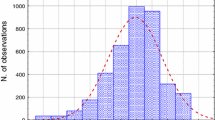Abstract
We propose a novel context sensitive algorithm for evaluation of ordinal attributes which exploits the information hidden in ordering of attributes’ and class’ values and provides a separate score for each value of the attribute. Similar to feature selection algorithm ReliefF, the proposed algorithm exploits the contextual information via selection of nearest instances. The ordEval algorithm outputs probabilistic factors corresponding to the effect an increase/decrease of attribute’s value has on the class value. While the ordEval algorithm is general and can be used for analysis of any survey with graded answers, we show its utility on an important marketing problem of customer (dis)satisfaction. We develop a visualization technique and show how we can use it to detect and confirm several findings from marketing theory.
Similar content being viewed by others
References
Anderson EW (1994) Cross-category variation in customer satisfaction and retention. Mark Lett 5(January):19–30
Anderson EW, Sullivan M (1993) The antecedents and consequences of customer satisfaction for firms. Science 12(2): 125–143
Anderson EW, Fornell C, Lehmann D (1994) Customer satisfaction, market share and profitability: Findings from Sweden. J Marketing 58(July):63–66
Anderson RE (1973) Consumer dissatisfaction: the effect of disconfirmed expectancy on perceived product performance. J Mark Res 10(February):38–44
Breiman L, Friedman JH, Olshen RA, Stone CJ (1984) Classification and regression trees. Wadsworth Inc, Belmont, CA
Cardozo RN (1965) An experimental study of customer effort, expectations, and satisfaction. J Mark Res 2(August):244–249
Churchill GAJ, Surprenant C (1982) An investigation into the determinants of consumer satisfaction. J Mark Res 19:491–504
Duda RO, Hart PE, Stork DG (2001) Pattern classification, 2nd edition. Wiley, New York
Einhorn HJ, Hogarth RM (1981) Behavioral decision theory: processes of judgement and choice. Annu Rev Psychol 32:53–88
Hong SJ (1997) Use of contextual information for feature ranking and discretization. IEEE Trans Knowledge Data Eng 9(5):718–730
Kononenko I (1994) Estimating attributes: analysis and extensions of Relief. In: De Raedt L, Bergadano F (eds) Machine learning: ECML-94. Springer Verlag, Berlin, pp 171–182
Kononenko I (1995) On biases in estimating multi-valued attributes. In Proceedings of the International Joint Conference on Artificial Intelligence (IJCAI’95), Morgan Kaufmann, pp 1034–1040
Mittal V, Kamakura W (2001) Satisfaction, repurchase intention, and repurchase behavior: investigating the moderating effect of customer characteristics. J Marketing Res 38(February):131–142
Mittal V, Ross WJ, Baldasare P (1998) The asymmetric impact of negative and positive attribute-level performance on overall satisfaction and repurchase intentions. J Marketing 62(January):33–47
Oliver RL (1993) Cognitive, affective and attribute bases of the satisfaction response. J Consumer Res 20:418–430
Oliver RL (1997) Satisfaction: a behavioral perspective on the consumer. McGraw-Hill, New York
Peeters G, Czapinski J (1990) Positive-negative asymmetry in evaluations: the distinction between affective and informational negativity effect. Eur Rev Soc Psychol 1:33–60
Quinlan JR (1993) C4.5: programs for machine learning. Morgan Kaufmann, San Francisco
Robnik-Šikonja M, Kononenko I (2003) Theoretical and empirical analysis of ReliefF and RReliefF. Mach Learning J 53:23–69
Sethi V, King R (1999) Nonlinear and noncompensatory models in user information satisfaction measurement. Inform Syst Res 10(1): 87–96
Spreng RA, McKensey S, Olshavsky R (1996) A reexamination of the determinants of consumer satisfaction. J Marketing 60(July):15–32
Szymanski DM, Henard D (2001) Consumer satisfaction: a meta-analysis of the empirical evidence. J Acad Marketing Sci 29(1):16–35
Tse DK, Wilton P (1988) Models of consumer satisfaction formation: an extension. J Marketing Res 25(May):204–212
Yi Y (1991) A critical review of consumer satisfaction. In Zeithaml VA (ed) Review of marketing. American Marketing Association, Chicago, pp 68–123
Author information
Authors and Affiliations
Corresponding author
Additional information
Responsible editor: Charu Aggarwal.
Rights and permissions
About this article
Cite this article
Robnik-Šikonja, M., Vanhoof, K. Evaluation of ordinal attributes at value level. Data Min Knowl Disc 14, 225–243 (2007). https://doi.org/10.1007/s10618-006-0048-4
Received:
Accepted:
Published:
Issue Date:
DOI: https://doi.org/10.1007/s10618-006-0048-4




